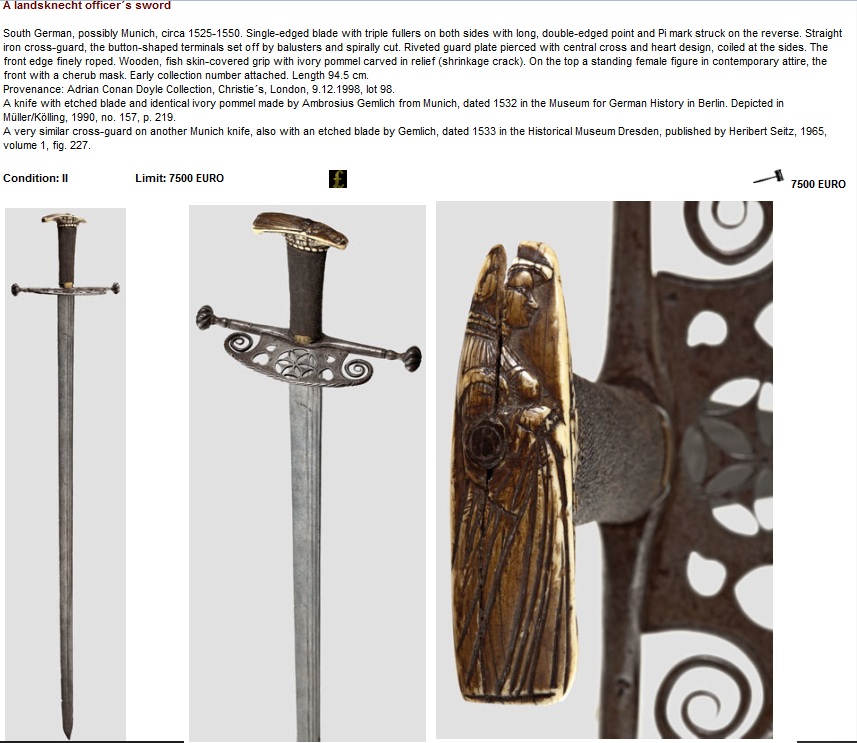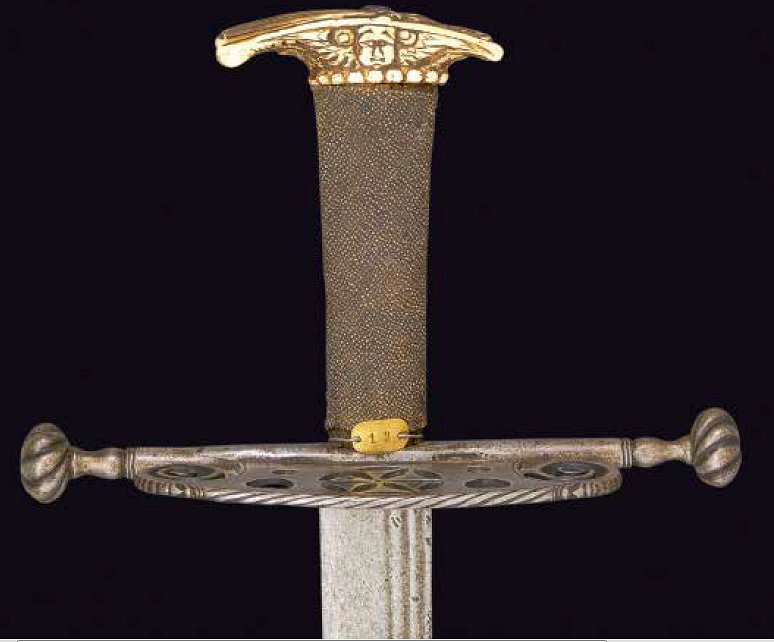| Author |
Message |
|
Radovan Geist
|
 Posted: Thu 05 Dec, 2013 4:41 am Post subject: Landsknecht sword/messer Posted: Thu 05 Dec, 2013 4:41 am Post subject: Landsknecht sword/messer |
 |
|
Does anybody know anything more about this wonderful landsknecht sword/messer? It has been auctioned some time back on Herman Historica, and a similar piece (with more sword-like handle and pommel) is in Vienna (Kunsthistorisches Museum).
It was described quite well on HH website, but there are some things that are not clear to me:
1) How is the plate attached to the cross-guard. Description say it is "riveted". Does it mean that there is a slot along the cross-guard, the plate is pressed into it and then riveted to secure? that looks like the sturdiest way of attaching it, but I see no signs of rivets on the guard from the top view. It could have been riveted below the cross-guard, but again I would expect some signs of rivets on the top. The third possibility is that the rivets are integral with the plate, and do not go trough the cross-guard from up - down ("vertically"), but from front to back ("horizontally"), maybe combined with a shallow slot... a real mystery.
2) It seems that the plate is not reinforced on the front side - no thicker "fold" or border is visible, and the description is not mentioning it (it says that the front edge is "finely roped", but that could be done without thickening the plate). However, that would mean that the coiled sides would be quite weak, easy to bend - unless the whole plate is really thick or made from hard steel. What do you think?
3) And that relates to another question. Is it a functional weapon, or more a parade piece, showing the rank of the bearer. The blade looks very functional. On the other hand, ivory pommel is would be fragile (at least compared to a steel one), and then there is this issue with the coiled sides of the plate...
4) Last but not least, description does not say anything about the thickness of the blade and its profile. Does anybody have more stats for this one, or a similar one?
Thank you in advance for any help.

 Attachment: 176.04 KB Attachment: 176.04 KB
[ Download ]
|
|
  |
 |
|
T. Kew
Location: London, UK Joined: 21 Apr 2012
Posts: 256
|
 Posted: Thu 05 Dec, 2013 5:23 am Post subject: Posted: Thu 05 Dec, 2013 5:23 am Post subject: |
 |
|
That is rather beautiful. It reminds me a lot of Sean Flynt's Hauswehr from E. B. Erickson. In fact, I wonder if that's the piece he referenced there as having an ivory pommel.
As for practicality, I think we might sometimes overestimate how much a sword will get used. Especially a piece such as this one would not have been a primary weapon for any wielder, but rather a secondary or backup piece, used rarely in an actual fight. The overall durability is thus less of a problem than we might guess. After all, you're using it for five minutes in a battle until you acquire a new halberd. So you might as well have a pretty weapon instead, which this certainly is - it's practical enough to kill someone in a pinch, but stylish and would go wonderfully with your tastefully understated Landschnect outfit.
Looking at the guard, I'd guess it's riveted horizontally through the cross in a few places, but you'd need a more extensive set of pictures to really be able to tell. It could just be neatly peened and well-finished, as that can make rivets near-invisible.
HEMA fencer and coach, New Cross Historical Fencing
|
|
  |
 |
|
Peter Johnsson
Industry Professional
|
 Posted: Thu 05 Dec, 2013 5:25 am Post subject: Posted: Thu 05 Dec, 2013 5:25 am Post subject: |
 |
|
It is indeed a fine sword.
Personally, I have no doubt it is a completely functional sword made for use.
We must however understand that a sword made for use, might never have been used. Sword fights were not something you entered on daily basis. Therefore a sword might express the wealth and status of its owner just as much as his readiness to fight for his honor and his life. Both aspects may have been equally important when a person did chose his weapon. A fine sword may speak of a fine swordsman. -A good reason to keep a civil attitude and a healthy distance?
To answer your questions:
1) The plate is most probably attached like the nagel of a messer: A transverse rivet shank transfixes the guard and the blade and is peened to form a (countersunk) rivet head on the back side of the hilt. There could well be two or more additional rivet shanks piercing the guard towards the ends of the plate. Perhaps a total of three in number? One in the center and one on each side?
2) The plate does not have to be reinforced since it is thick enough to support itself. It is thicker than the filling plate you see on later era rapier hilts. This is a fairly substantial plate that is lightened by the elegant piercing work.
3) As said before: a functional piece. It would be light in the hand with the slim blade. It would not need much in the way of "counter balance" of a pommel. The distal taper is most likely very effective with a sturdy base, quickly growing thinner to a medium thick mid section and a point that is very thin. Typically a three stage taper: dramatic at first, slow in the middle and then more pronounced towards the point. This makes for a thin and light blade that feels stiff and resilient. The back edge also helps a lot in reducing the mass in the point.
4) I do not know the details of this one, but at a guess I would think it starts out at around 5 mm, thinning down to around 3.5 mm after the first 10 - 15 cm. It then very gradually tapers down to around 2.8 mm at a distance about a third of the length from the point where the distal taper increase to around 1.2 mm right behind the point. The cross section is very lean with the thin edge and a narrow zone of sharpening. The edge will be rather similar to that of a butcher´s knife.
-That is my guess.
It can start out slightly thicker or thinner, but the overall distal taper would be adjusted to achieve the same effect.
Such a blade will feel natural and responsive in the hand, allowing for quick and precise actions.
|
|
   |
 |
|
Radovan Geist
|
 Posted: Thu 05 Dec, 2013 6:55 am Post subject: Posted: Thu 05 Dec, 2013 6:55 am Post subject: |
 |
|
Gentlemen, thank you both for your comments. I do agree - three "horizontal" rivets would do the job. I was wondering about the rivet piercing through the blade, and was not sure about it, but it´s impossible to tell for sure unless I find some pictures of the reverse side.
just FYI, here is the similar piece from Vienna that I was mentioning in my original post (first few pictures in the set): http://www.flickr.com/photos/98015679@N04/set...45/page18/
Thanks again, and any further comments are welcome.
|
|
  |
 |
Sean Flynt

|
 Posted: Thu 05 Dec, 2013 7:17 am Post subject: Posted: Thu 05 Dec, 2013 7:17 am Post subject: |
 |
|
Yes, that's the same sword shown at the bottom of the page in my Hauswehr thread linked above (see multiple close views there).
You can also see that the weapon on which mine is based is a very plain example, with wooden pommel of a piece with the grip. It's a civilian weapon associated with Martin Luther or his followers. I suspect that the ivory example(s) are also meant to be civilian arms for upper-middle class men. These organic pommels seem to be distinctively South German.
As Peter suggests, the wooden pommel, complex guard and thoughtful blade choice combine to create a light, well-balanced and responsive weapon whose weight would be barely noticeable on the hip while walking around town or riding on a long journey. The blade of my piece is as close as possible to that of the original--a thin lenticular section with a triangular tip that allows thrusting without compromising the slashing ability. It isn't heat-treated, but it's a wonderful match for the hilt.
-Sean
Author of the Little Hammer novel
https://www.amazon.com/Little-Hammer-Sean-Flynt/dp/B08XN7HZ82/ref=sr_1_1?dchild=1&keywords=little+hammer+book&qid=1627482034&sr=8-1
|
|
   |
 |
|
Cornelis Tromp
Location: Holland Joined: 03 Jan 2010
Posts: 87
|
 Posted: Wed 11 Dec, 2013 3:18 am Post subject: Posted: Wed 11 Dec, 2013 3:18 am Post subject: |
 |
|
I think the parry plate can be brazed with a copper alloy, same way as the blades of mace in the mid 16thCh.
Herewith some better pics.
best,
 Attachment: 55.96 KB Attachment: 55.96 KB

 Attachment: 69.02 KB Attachment: 69.02 KB
[ Download ]
|
|
  |
 |
|
Radovan Geist
|
 Posted: Wed 11 Dec, 2013 11:06 pm Post subject: Posted: Wed 11 Dec, 2013 11:06 pm Post subject: |
 |
|
|
thank you! these pics helped a lot! especially the second one shows nicely the roping, thickness of the plate, and the was plate fits into a slot in the cross-guard. Brazing might be a good idea, too.
|
|
  |
 |
|
Mike Ruhala
Location: Stuart, Florida Joined: 24 Jul 2011
Posts: 335
|
 Posted: Thu 12 Dec, 2013 7:21 am Post subject: Posted: Thu 12 Dec, 2013 7:21 am Post subject: |
 |
|
|
Neat piece! The configuration is reminiscent of the hangers that would serve as backup weapons to muskets for the next couple centuries. The shells on those later pieces are often made separately from the cross and held in place by simple compression. Spiral finials wouldn't have been my first choice but the most interesting use of a shell like that isn't catching cuts in kron it's using it to take opposition and that wouldn't subject it to much stress. It looks perfectly functional to me but everything about it suggests it was made for a man who's educated in swordsmanship rather than someone who relies on the good ol' hack and slash.
|
|
  |
 |
|
|
You cannot post new topics in this forum
You cannot reply to topics in this forum
You cannot edit your posts in this forum
You cannot delete your posts in this forum
You cannot vote in polls in this forum
You cannot attach files in this forum
You can download files in this forum
|
All contents © Copyright 2003-2024 myArmoury.com — All rights reserved
Discussion forums powered by phpBB © The phpBB Group
Switch to the Basic Low-bandwidth Version of the forum
|

